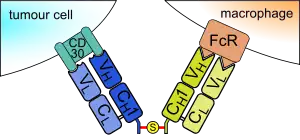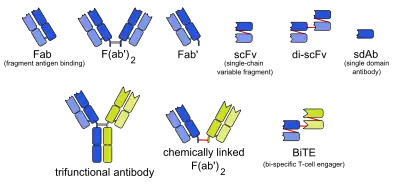Chemically linked Fab
Two chemically linked fragments antigen-binding form an artificial antibody that binds to two different antigens, making it a type of bispecific antibody. They are fragments antigen-binding (Fab or Fab') of two different monoclonal antibodies and are linked by chemical means like a thioether.[1][2] Typically, one of the Fabs binds to a tumour antigen (such as CD30) and the other to a protein on the surface of an immune cell, for example an Fc receptor on a macrophage. In this way, tumour cells are attached to immune cells, which destroy them.[3]

In the late 1990s and early 2000s, clinical trials with chemically linked Fabs were conducted for the treatment of various types of cancer. Early results were promising,[3][4] but the concept was dropped because of high production costs.[5]
Bi-specific T-cell engagers employ a similar mechanism of action while being cheaper.
References
- Karpovsky, B.; Titus, J. A.; Stephany, D. A.; Segal, D. M. (1984). "Production of target-specific effector cells using hetero-cross-linked aggregates containing anti-target cell and anti-Fc gamma receptor antibodies". The Journal of Experimental Medicine. 160 (6): 1686–1701. doi:10.1084/jem.160.6.1686. PMC 2187539. PMID 6239899.
- Glennie, M. J.; McBride, H. M.; Worth, A. T.; Stevenson, G. T. (1987). "Preparation and performance of bispecific F(ab' gamma)2 antibody containing thioether-linked Fab' gamma fragments". Journal of Immunology. 139 (7): 2367–2375. PMID 2958547.
- Borchmann, P.; Schnell, R.; Fuss, I.; Manzke, O.; Davis, T.; Lewis, L. D.; Behnke, D.; Wickenhauser, C.; Schiller, P.; Diehl, V.; Engert, A. (2002). "Phase 1 trial of the novel bispecific molecule H22xKi-4 in patients with refractory Hodgkin lymphoma". Blood. 100 (9): 3101–3107. doi:10.1182/blood-2001-12-0295. PMID 12384405.
- Link, B. K.; Kostelny, S. A.; Cole, M. S.; Fusselman, W. P.; Tso, J. Y.; Weiner, G. J. (1998). "Anti-CD3-based bispecific antibody designed for therapy of human B-cell malignancy can induce T-cell activation by antigen-dependent and antigen-independent mechanisms". International Journal of Cancer. 77 (2): 251–256. doi:10.1002/(SICI)1097-0215(19980717)77:2<251::AID-IJC14>3.0.CO;2-E. PMID 9650561.
- Kellner, C (2008). Entwicklung und Charakterisierung bispezifischer Antikörper-Derivate zur Immuntherapie CD19-positiver Leukämien und Lymphome [Development and characterisation of bispecific antibody derivatives for the immunotherapy of CD19-positive leukaemia and lymphoma] (Thesis) (in German and English). Erlangen-Nürnberg: Friedrich-Alexander-Universität.
